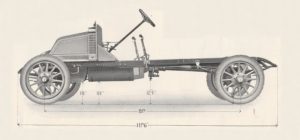
Introduction
The Phoenix name for this make of car has a curious origin. Belgian-born J. Van Hooydonk started his working life in England as a marzipan maker for the famous confectioners, Pascalls. He was a member of the Phoenix Cycle Club; when he began to make motorcycles in 1900 he named them after the club. He formed the Phoenix Motor Co. in 1903 with £10,000 capital, and started to make tricycles under the name of Phoenix Trimo, with Minerva engines imported from his native country. The four-wheeled Quad appeared in 1905 with a 2-cylinder Fafnir horizontal transverse engine. The first proper car arrived in 1908. Still with a transverse engine but now vertical, from Minerva or Imperia, it had chain drive to a 3-speed gearbox and chain final drive. It was designed by Albert Bowyer-Lowe.
The same designer was responsible for the far more advanced 11.9 H.P. car in this Technical Talk: a 1496cc 4-cyinder car with 3-speed gearbox and worm drive. It was built at Phoenix’s new factory in Letchworth, where they had facilities for making their own engines and many other components. About seven car a week were built by a workforce of 150. The model was built up to 1913 and revived after World War I, being replaced by the 12/25 in 1922.
A captivating catalogue
This Technical Talk was inspired and informed by the superb illustrations found in a Phoenix catalogue dating almost certainly from before World War I. The words and images in the catalogue give a persuasive message of high-quality design, engineering and manufacture.
The chassis
The chassis illustration was allowed to speak for itself. There were no outstanding design features to be seen here; these were about to be explained in detail.
The chassis.
“Outstanding Constructional Features of the Car”
The catalogue listed many of these features; among the most striking were:
– Lubrication by pump, with pump indicator on the dash.
– Fully floating back axle, with the half-shafts therefore taking the drive only, in a one-piece pressed steel casing.
– Three-speed and reverse gearbox with all shafts on ball bearings.
– Adjustable steering rake – and clutch and brake pedals both adjustable for height and angle.
– Petrol gauge in dash.
– Deep-seated Victoria body carrying three abreast and with ample luggage accommodation.
The body
“Seats Three Abreast” appears many times in the catalogue and was clearly considered to be a selling point – and there were other notable features set out in two body illustrations.
Full side view of the body, with a windscreen that could be set to any angle, and ample cushion dimensions and leg room. The caption reminded customers of the adjustable pedals.
The rear, with the spare wheel “strapped in”, a compartment above it for tools, and the platform fitted with hasps for passengers’ luggage.
The engine
Two views of the engine showed its neat construction. Further illustrations demonstrated attention to sufficient bearings: the centre bearing on the camshaft and the three-bearing crankshaft.
The carburettor side of the engine. Much is made in the description of the effective lubrication by dippers on the connecting rods that reach into oil troughs kept at a constant level by a pump fitted to the front of the engine. Another feature mentioned and shown here is the aluminium crankcase that extends to right and left and thus reached the chassis side members, “enabling a perfect fixing and keeping [the] whole engine shielded from mud and dust.”
The ignition side of the engine. Mention is made of the magneto, protected and yet accessible and driven off the half-time shaft, and the oil-tight casing enclosing the clutch and flywheel.
The three-bearing crankshaft, connecting rods, pistons, and white-metal-lined crankshaft bearings.
Solid engineering
Further illustrations give evidence of the high standards of construction of the engine. The skew (helical) timing gears give silent operation. A front view of the engine shows the accessibility of the oil pump, carburettor and magneto and, once again, the rigid fixing and protection from road dirt of the wide extensions of the aluminium crankcase. The oil pump is shown with its cover removed, revealing its simple construction.
The helical timing gears.
A front view of the engine, clearly showing the aluminium crankcase with its wide protective extensions.
The internal details of the oil pump.
The gearbox
This neat unit was said to have particularly short shafts to avoid any ‘springing’ out of gear, all running on ball bearings. Another clever touch mentioned in the catalogue was the construction of the gate gear change: it was integral with the gearbox, so that deflection of the chassis could not cause the changing mechanism to bind.
The gearbox, with its short shafts, ball bearings and integral gate change mechanism.
The back axle
The worm-drive back axle was another unit with a simple, solid design. Exterior and internal illustrations, and a fine image of the worm drive, indicated a high quality of engineering and manufacture.
An exterior view of the worm-drive back axle, showing the brake drums, detachable wheel hub, and drive-shaft enclosed in a torque tube.
A detailed close-up of the worm-drive unit. The spur-gear differential is hidden within it.
A final image
One final illustration showed a feature of the car that was mentioned earlier in the text but not visible elsewhere: the full metal undershield protecting the flywheel, clutch and gearbox.
A side view of the chassis, showing the protective undershield.
A conclusion
The Phoenix may well have been an unremarkable light car, typical of many made before the First World War – but the illustrations found in its catalogue reflect the undoubted confidence that Phoenix had in their product and made a powerful case for their claim to have produced a car of high quality.
Images courtesy of the Richard Roberts Archive




















Leave a Comment